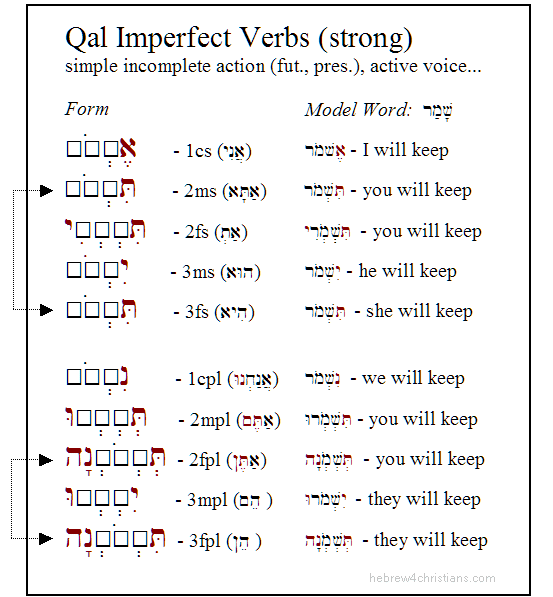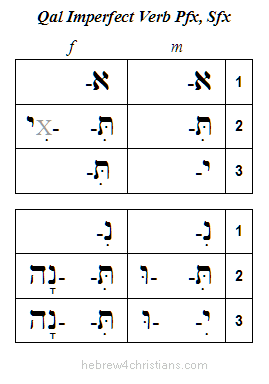|
The Qal Stem...
The most basic stem from the verbal root is called the Pa'al (ūżų╝ųĖūóųĘū£, based on the 3ms pattern) since it expresses the simple sense of the shoresh (e.g., "walk," "stand," "eat," and so on). Because it is the easiest and simplest form, it is called Qal (ū¦ųĘū£), meaning "light" or "simple." In most Hebrew lexicons and dictionaries, verbs are listed in the 3rd person masculine singular of the Qal (when it exists).
General properties of the Qal stem include:
- Active Voice - the subject is agent of verb (e.g., "I guarded")
- Simple Aspect - the action of the verb is simple (i.e., not reflexive or causal). In the perfect tense, the action is completed or "perfected" (i.e., past), while in the imperfect tense, the action is ongoing or not completed (i.e., present or future).
The Imperfect Conjugation
A conjugation is a set of inflected forms (of a given verb stem) based on person, gender, and number. The imperfect conjugation is used to denote incomplete (or undefined) action. For now, think of the imperfect conjugation as the future tense in the active voice. The imperfect conjugation for Qal verbs, then, is a set of inflected forms (of the Qal stem) that represents future action performed by the subject of the verb. Infections are made by adding both prefixes and suffixes to the verb to indicate gender, person and number.
Strong and Weak Verbs
As mentioned in the Introduction to Hebrew Verbal System, Hebrew verb roots are divided according to whether the verb is regular or irregular with respect to one (or more) of its letters. Regular verbs have no weak letters (i.e., gutturals) in the shoresh and therefore they are called "strong" verbs; weak verbs, on the other hand, have one or more guttural letters in the root. The root ū®ūü.ū×.ū© is strong since none of its letters is a guttural. In a Hebrew lexicon, ū®ūüū×ū© would be listed as shamar (ū®ūüųĖū×ųĘū©), that is, with the vowels for the 3rd person masculine singular (3ms) of the Qal perfect conjugation added. This is known as the "lexical form" of the verb (so if you want to look up an imperfect form of a verb you must first know the 3ms of the perfect form and look for that in your lexicon).
Again, infections of the imperfect stem are made by adding both prefixes and suffixes to the verb. The following conjugation shows the Qal imperfect for the root ū®ūü.ū×.ū©.
 |
The following "diagnostic" table further summarizes the pattern changes of a strong verb in the Qal imperfect conjugation:
 |
Notes:
- The Imperfect conjugation is used to express incomplete action, usually in the present or in the future.
- The form of the verb itself contains pronominal information, and I included the personal pronouns for reference purposes only. In other words, eshmor means "I will keep" without the use of the word ani (in fact, ani eshmori could mean "I myself will keep"). Learning the endings along with the pronouns is somewhat easier since the sounds of the pronouns often resembles the suffixes. As for the prefixes, note the first person forms are easy enough (ūÉ or ūĀ); all the second person forms use (ū¬ų╝), both the third person masculine singular and plural use (ūÖ).
- You simply must memorize this as a paradigm for the Qal imperfect. The endings are the same for all imperfect verbs.
- The first person forms for both genders (1cs) and plural (1cp) are the same. That is eshmor can be singular for either gender, as can nishmor.
- The prefixes and suffixes for the Qal Imperfect are as follows:

- Be aware that the meaning of the imperfect in Hebrew is more complex than the simple future tense in English. For instance, depending on context, eshmor might mean "he will keep," "he will have kept," "he kept," etc.
- The normal word order in Hebrew is: verb - subject - object.
|
|







